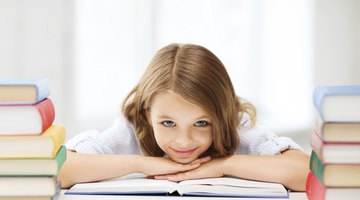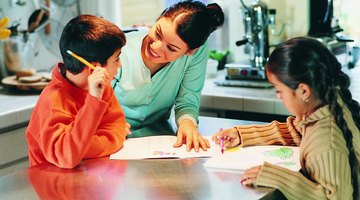The Education of Children of Single Parent Homes
In 2004, about half of all U.S. children could expect to still be living with both their biological parents by the time they reached age 15, according to the Social Science Research Network. With the increase of divorce rates throughout the United States and elsewhere in the world, single-parent homes are a major segment of all households with children. Accordingly, it's a point of intense interest to educators and parents how a single-parent environment affects children's learning.
Potential Challenges
Typically, single parents have to manage far more tasks than the mothers or fathers in two-parent households, simply because of practical limitations on the division of labor. At least until children are old enough to take on household chores, all the housekeeping responsibilities fall on one person, as well as wage earning and parenting. As a result, it's possible for single parents to have less time or energy to encourage their children's learning by reading together, overseeing homework or planning educational, entertaining and fitness activities and outings for the family.
Education and Behavior

The Effects of a Single Parent Home on a Child's Behavior
Learn More
Aside from the direct influence of household structure on academic achievement and learning, a single-family home environment may influence a child's behavioral performance in school, which can indirectly affect learning and interest in school. According to Adoption.com, when single parents are working full time and therefore have less available time for their children, the situation may lead to either behavioral issues or lower academic achievement.
Historical Trends
In the late '80s, when single-parent homes were less common than at present, a study carried out at the University of Illinois at Urbana, reported by "The New York Times," found that children raised by one parent were less likely to continue their schooling through high school and into college. From a sample of 2,500 children, the longer kids were in single-parent households, the shorter their educations. Since the early 1990s, however, a new model has become the standard for statistics measuring academic performance in children of varied household types. Instead of using a Family Deficit Model, which presupposes that single-parent households are incomplete and nonstandard, contemporary statistics instead use a Risk and Protective Factor Model. The model views family structures based on multiple risk factors, including positive and negative life events and general characteristics of the family unit.
Understanding Statistics

Family Factors That Influence Students' Behavior in School
Learn More
Sociologists continue to chart the relationship between household structure and academic performance. With the increasing prevalence of single-family homes and continuously changing methods of measuring educational performance, it's impossible to reduce the relationship to one of direct cause and effect. According to Adoption.com, statistics such as a 1992 study published in the journal "Sociology and Education" show that children from one-parent households generally evidence lower academic achievement. However, the site also points out that many studies, including the 1992 investigation, indicate that income level has much greater effect on education than family structure.











